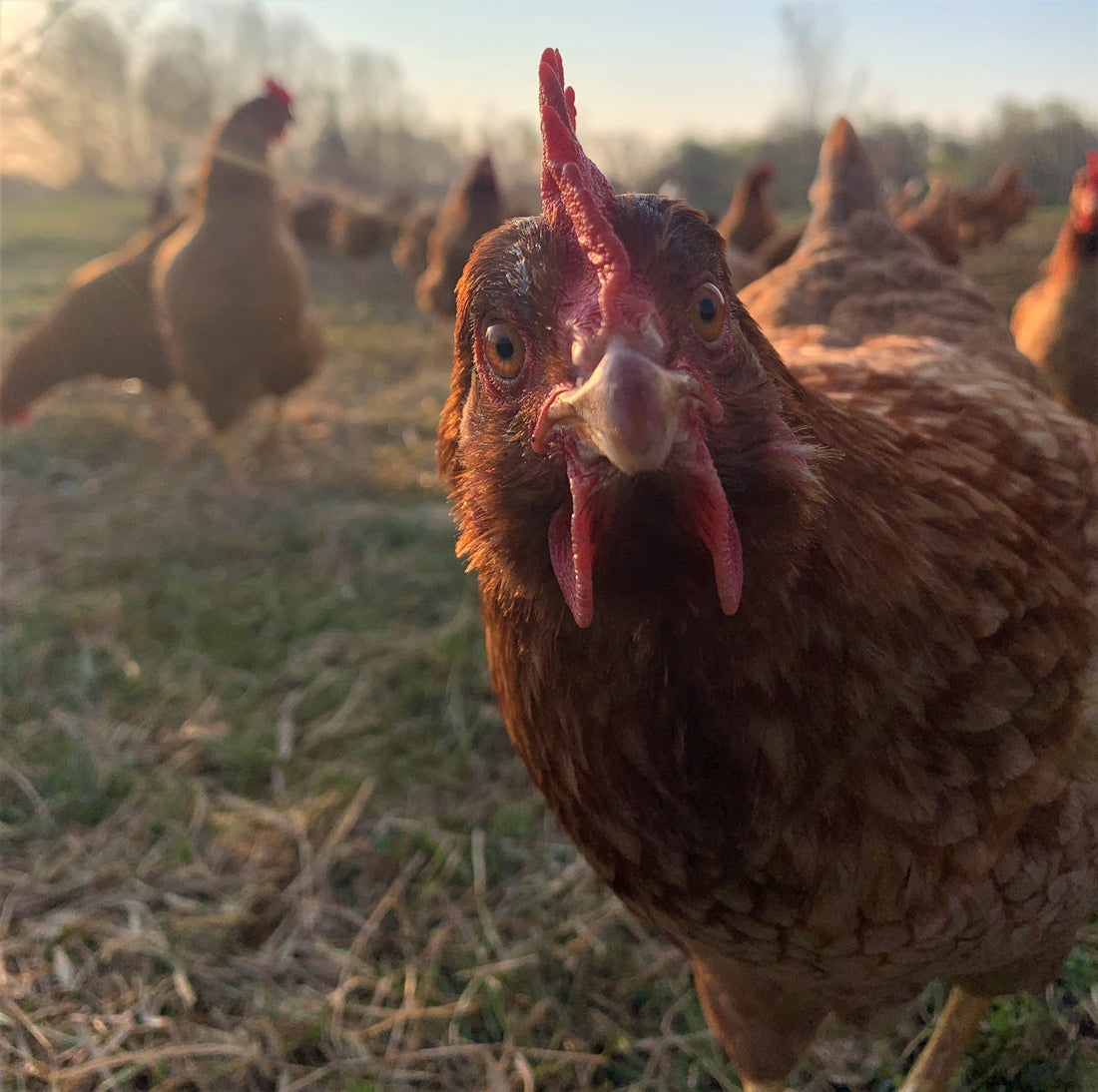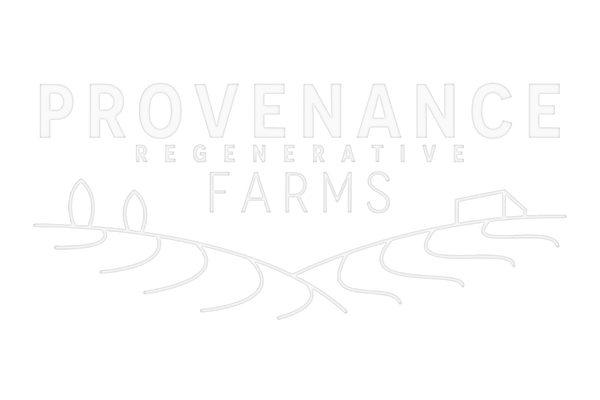
What are Regenerative Hens (and eggs) anyways?
Share
People ask us all the time…
What does ‘Regenerative’ mean anyways?
So what makes your hens, and their eggs, “regenerative”?
How are they different from conventional or even organic eggs?
How do you ‘Regenerate’ the soil in the winter??
What does ‘Regenerative’ mean anyways?
Simply put, Regenerative Farming amplifies existing nutrient cycles, evolved in nature, to rebuild a currently degraded ecosystem.
It’s the rebuilding that makes it regenerative, as opposed to sustainable. Sustainable is fine when things are in good shape, but that’s typically not the case with most of our productive land.1
So what makes your hens, and their eggs, “regenerative”?
With respect to our hens, we’re harnessing two aspects of their behaviour to regenerate top soil;
- Their diet and subsequent manure deposits,
- Their physical behaviour of scratching and pecking the soil.
Their Diet: Chickens are Omnivores; they eat bugs, maggots, frogs, and snakes, as well as grasses.
Hens are omnnivorous.2
Although a variety of scholarly papers and books classify chickens and turkeys as granivores, they are omnivores and do not have the food preferences, digestive anatomy, or nutritional strategies that would classify them as granivores. Their wild relatives consume a very wide variety of food items of both plant and animal origin, and seeds are not often a primary component. Intake of insects by jungle fowl chicks and wild turkey poults exceeds 50% of their diet…2
They’re also voracious.
Originally a jungle bird2, the modern hen will spend up to 90% of its time foraging; scratching at the ground with both feet, then eating what’s been uncovered.
Put a hundred hens in a 1500 sq ft patch of field for a week, and they’ll render a lush pasture into a brown, grassless patch of soil. They’ll eat the grass down to the root, find all the bugs, all the snakes, all the frogs, and any other source of protein they can. They’ll devour it all, and replace it with manure.
So before we let them devour everything, we add a management technique; We move them to a fresh patch of pasture.
This allows for regeneration to begin, as;
- We haven’t allowed the plants to be killed, which still have a healthy amount of green leaves. They’ll regrow.
- The plant species will photosynthesize, capturing the sun’s energy, pulling in carbon dioxide from the atmosphere, water from the soil, metabolizing to create energy-rich carbon molecules and Oxygen.
Here’s the equation3: CO2 + H2O + light energy → energy-rich carbon molecules + O2
Now let’s think about their manure!
Poultry manure contains all 13 of the essential plant nutrients that are used by plants. These include nitrogen (N), phosphorous §, potassium (K), calcium (Ca), magnesium (Mg), sulfur (S), manganese (Mn), copper (Cu), zinc (Zn), chlorine (Cl), boron (B), iron (Fe), and molybdenum (Mo). Plant nutrients originate from the feed, supplements, medications, and water consumed by the animals. Using poultry manure as a fertilizer for crops or trees may provide a portion, or all, of the plant requirements.3
In the process of scratching and pecking every square inch of pasture, the hens deposit their manure.
This physical process breaks up thatch and under-growth, exposes the top layer of soil without actually turning it over as a plow would, and spreads fertilizer (their manure). Even at night, when asleep in their hen-mobile, their manure falls through the wire grate floor and onto pasture.
Root to Shoot Ratio (RSR) and why it matters
Remember how we move our hens before they devour everything? We decide when to move them by actively observing how much of the grass has been foraged. Specifically we’re observing how much plant shoot is left.
By consuming most, but not all, the plant, the hens are triggering a process below-ground that improves the nutrient profile of the topsoil.
The root systems are sized proportionately to the plant, which is affected by multiple internal and external factors including the size of the ‘shoot’ we see above ground.
When parts of the shoots are removed, plants tend to compensate this by lower root growth and returning to a ratio characteristic for the species.5
So, when our hens eat the grass (reducing the plant’s above-ground volume), the root system is triggered to shed its now superfluous root structure to be broken down by the ecosystem of microbes directly adjacent to the physical root structure, a process call rhyzodeposition6.
This process unlocks the minerals and carbon, and increases the soil organic matter (SOM) of the topsoil.
This cycle happens naturally in nature. Think of herds of buffalo roaming a plain. The herds will stay put until they’ve eaten all the grassland down to the nub. They’ll move along, grazing along the way, pressured to move by predators and attracted to move by more lush pasture.
How are they different from conventional, organic, or free-range eggs?
Regenerative egg production
As we’ve described, regenerative egg production specifically mimics the natural cycle of intensely grazing mobs, moving quickly across a plain. So when we deploy our hens to a new fenced-in paddock, we’re doing so with the specific intent to balance the space our hens require with the density and time required to pressure a piece of pasture into a regenerative cycle.
When we do this, our hens spend a day or two at most in one place. Before we let them out the next day, we hitch their mobile-hen-home (it’s built on a trailer frame and is on wheels) to our electric utility vehicle and move them to an adjacent paddock. We setup portable electric fencing to keep them in, keep predators out, park the hen-home, and let the hens out again, thus restarting the regenerative cycle.
Conventional egg production
In contrast, conventional egg production flips the process; Instead of moving the hens, the hens are housed in a barn and the feed and manure is moved. This process is generally more scalable as temperature and predator control can be managed more easily, while egg collection can be automated, but trades off for increased animal density. New animal welfare regulations in Canada (as well as the U.S. and the E.U.) require an enriched housing environment to encourage more natural behavioural expression of the hens.
Organic egg production
Organic egg production follows a conventional egg production model, but adds a certified organic feed, and ensures that the hens themselves have a prescribed minimum amount of space higher than the minimum required for conventional egg production.
Free Range?
Some organic or even conventional egg production will offer their hens the choice to access the outdoors. Because the egg production happens in a barn, the outdoor location is not typically moved, hence any regeneration that occurs is limited to the space around the physical barn. Hens may choose to stay indoors or roam outside. Free-range eggs can be conventional or organic.
How do you ‘regenerate’ the soil in the winter?
In the winter, the most important aspect is the welfare for the hens. We want to give them as much opportunity to express their natural chicken behaviour as possible.
We house them in a green house, with full access to day light. We build their roost bars and their nest boxes here.
While the greenhouse protects from wind and wet, it also insulates as it is double walled to protect from the extreme cold temperatures.
Even though our hens can survive extreme cold, their egg production will drop off to almost zero if they’re not able to keep warm enough. They’ll focus their caloric intake towards heat production rather than egg production, so it’s important we manage this well.
Despite this, they’ll still have access to the outdoors where we put down hay and straw over the snow. This gives them a surface to walk on that keeps their feet out of the pure cold of the snow and gives them something to forage on, as the hay is sourced from that summer’s hay harvest, typically alfalfa.
In the spring, their manure is collected from the greenhouse and composted. The composting process renders any pathogens or bad bacteria inert and allows us to use all that bedding material and manure in the production of other products on the farm.
In Short
In short, what qualifies regenerative hens and their eggs as actually regenerative is their use within an active and explicitly managed approach to regenerating the soil. To do this means developing a deep and nuanced understanding of how energy, nutrients, and water cycle through our environment, and the role in which animals have co-evolved in propagating these cycles.
It’s an intellectual and management-intensive approach. Regenerative farming requires the farmer adopt a curious and rather humble mindset of facilitator and conductor so as to truly understand the nature of the cycles at work, how to finesse them for the specific land to be regenerated, without breaking the cycles in the process.
Like all crafts that require deep understanding before the sense of competence is developed, it’s deeply satisfying to set up systems that begin to self-perpetuate, even attracting others in the community to get involved.
If ever you would care to, please drop us a note.
We want to hear from you.
Footnotes:
1 Strether, L., & View all posts by Lambert Strether →. (2020, September 13). Topsoil degradation, soil erosion, and soil governance (global or otherwise). Naked Capitalism. https://www.nakedcapitalism.com/2020/09/topsoil-degradation-soil-erosion-and-soil-governance-global-or-otherwise.html
2 Klasing, K. C. (2005). Poultry nutrition: A comparative approach. The Journal of Applied Poultry Research, 14(2), 426–436. https://doi.org/10.1093/japr/14.2.426
3 Jean-François, M.-G. (2020, February 26). The path of carbon in photosynthesis. Encyclopedia of the Environment. https://www.encyclopedie-environnement.org/en/life/path-carbon-photosynthesis/
4 Chastain, J. P., Camberato, J. J., & Skewes, P. (n.d.). Poultry manure production and nutrient content. Clemson.Edu. Retrieved January 25, 2022, from https://www.clemson.edu/extension/camm/manuals/poultry/pch3b_00.pdf
5 Lynch, J., Marschner, P., & Rengel, Z. (2012). Effect of internal and external factors on root growth and development. In Marschner’s Mineral Nutrition of Higher Plants (pp. 331–346). Elsevier. https://doi.org/10.1016/B978-0-12-384905-2.00013-3
6 Villarino, S. H., Pinto, P., Jackson, R. B., & Piñeiro, G. (2021). Plant rhizodeposition: A key factor for soil organic matter formation in stable fractions. Science Advances, 7(16). https://doi.org/10.1126/sciadv.abd3176


1 comment
Great article! Thanks El & Andrew